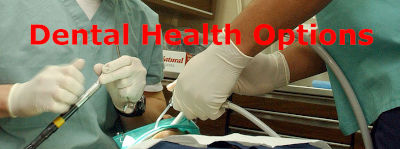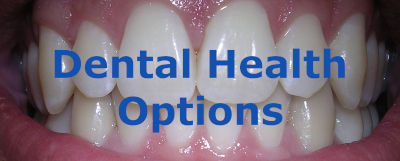Dental Health Options?

When searching for a dentist it is good to know what to look for. This will help you to asses your options.
- How close is the dentist's office to your home or work? Is it easy to get to?
- Will the dentist take your insurance?
- Are they an ADA member?
- Do their hours work with your schedule?
- Do they speak your language?
The ADA actually has a dentist finding tool: HERE .
When it comes to deciding on your dental health care, what you potentially can and cannot afford, especially, there’s no better option than assessing your budget and needs, as well as the marketplace around you that’s offering numerous package deals. And that’s what we’re going to talk about today ---- don’t miss it and keep reading for more…..
Dental Health Options In Different States
The state that many consider to have the worst dental health and dental health options combined…..
First of all, most dental health package options vary by state and by employer, respectively. And recent findings from this year alone have shown what some of the very best --- not to mention the very worst --- U.S. states are for getting dental health care. You want to know what they are? Let’s start with the worst, saving best for last; that’s usually the best way to present anyone with information --- we’ll keep you reading til the end…..
First of all, ranked as the worst of the worst, in possibly every sense and more, is the state of Mississippi, which brings in a total oral score of 34.01 and an Oral Health rank of 49 (out of 50), along with a Dental Habits & Care rank of 47 (out of 50). Its overall ranking left it in 51st place. Terrible news for residents of the lovely state, right? But let it serve as a wakeup call to you, if you are living in Mississippi, then guess what --- you need to either a.) take better care of your oral health and see a dentist more often, or at all ---- or b.) not get health care there as a result of rising spike dental health costs there, as a result of a.). That’s the sad fact of the matter, but moving on…..

The need for greater ‘extensive’ oral health care in U.S. states, especially for those with Medicaid coverage already…..
Also, there’s a few reasons we can think of as to why your state --- every state, in fact --- ought to offer some extensive coverage to you if you’re already on Medicaid, for instance. And here they are:
Dental Health Options - Insurance
First of all, adding a more comprehensive range of oral health benefits to already pre - existing packages with Medicaid can, in fact, be quite cost - effective on the state’s budget (regardless of the state itself) and thus on the country’s economy as a whole. The ADA, or American Dental Association, found in 2016 that adding this benefit would actually increase total Medicaid spending within the state by a mere 0.4 to 2.1 % , which is more than doable. It’s affordable and won’t take a huge hit economically, so it can and should be done. Plus, the state affected will actually see fewer emergency visits that are oral - health related in nature, as well, while also being better able to manage its own chronic diseases and even find related jobs more easily; it’s a win in everyone’s book, then.
In addition, without such dental health coverage or its additional supplemental range of benefits just mentioned, for example, you can expect low - income adults to face quite a rising barriers getting in their way from them being able to get any type of oral coverage at all. And that’s a sad fact. But furthermore, in these last 12 months alone, more than ¼ of all low - income adults reported that they weren’t able to get even the minimum amount of dental health care they needed due to the rising cost of each package available in their area; this will, in turn, create major problems in other areas of their life, health and happiness as a whole, the findings concluded.
But to add to this, these people are two times as likely to attract dental caries, a known oral bacteria disease causing countless more cavities in its wake, than those with a higher income who could otherwise afford such care. And more than 20 % of all such adults living in this country have unfilled cavities, and over 50 % of people in this category are likewise missing 5 or more teeth. It’s truly a cause - and - effect dilemma plaguing many.
And as mentioned just briefly in several other major modern dental news sources this year, getting such an additional - coverage plan put into place through Medicaid will help all states save on their budget in terms of emergency oral care needs. That’s a fact. 2012 U.S. emergency dental care costs surpassed 1.6 billion. There’s got to be a better way…..

Not only that, but the ADA has recently found that nearly 80 % of all emergency dental visits within the U.S. could even be diverted to community settings, a plan which has to take place soon. Doing so would even save nearly 50 % off the cost of each visit alone. For instance, here’s how it could break down --- treating an emergency during an ER visit is shown to cost $750 in some instances, whereas if the issue is taken care of in a community setting, that cost can be expected to drop to $390. Major budget - cost difference, right? We all concur.
Plus, there’s the simple fact of the matter that, as people age, saving their teeth and living well become more crucial personal and dental health matters than ever before, right? And those with incomes under $15,000 annually, who are also 65 and older, are missing teeth that have fallen due to decay or disease --- not to mention neglect of care due to high cost of coverage. 3 out of 5 seniors with such low incomes make up the count here. So once again, something must take place to fix this growing issue…..
Final Thoughts
Some states like Mississippi offer terrible dental health coverage, or in some areas, no coverage at all. And as a result, these states see the worst dental health overall. But all in all, incorporating extended coverage options across all states would be a huge benefit to the nation as a whole!
